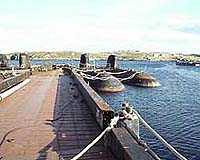 Nuke sub disposal
Nuke sub disposal
Moscow - Jul 17, 2008: Russia's main partners in the process of dismantling old Soviet navy nuclear submarines are Britain, Germany, Norway, Sweden and France. The program was supported by the Northern Dimension fund, the TACIS program -- an EU program for technical assistance -- and the International Atomic Energy Agency. Today Russia has agreements with the United States, Canada, Italy and Japan.
Rosatom reports that in the past six years foreign partners have financed the complete dismantlement of 26 submarines, and 14 more vessels are in the line. The bulk of the costs, however, are borne by Russia, which is financing the dismantlement of 70 vessels. The mass of metal that was once Russia's nuclear navy totals 1.5 million tons. The special trains will have to run at least 100 journeys to transfer that daunting mass from Russia's northwest to the Mayak chemicals plant near Chelyabinsk in the Urals, which holds the monopoly on recycling nuclear waste. However, the trains are capable of running only 10-15 journeys a year. This means no rapid evacuation is possible, and the remnants of nuclear submarines will remain on Russia's shores for a long time to come.
Theoretically, dismantlement is considered complete after all the nuclear materials and equipment of a submarine are recycled. However, because of a high level of residual radiation, a submarine's reactor plant takes 50-70 years before it can safely be dismantled, unless young physicists invent something new in the meantime. Reactor compartments are therefore extracted from submarine hulls, isolated and put into storage areas. Yet there is a shortage of storage space, and some of these compartments are kept afloat.
These "floating coffins" worry Russia's European neighbors most, though the situation is improving. With Germany's financial assistance, a long-term storage facility for reactor compartments from all over the northwestern part of Russia is being built at the Sayda Bay on the Kola Peninsula.
Experts urge people not to yield to radiophobia, as fears of environmental disaster at the dismantlement site are almost baseless.
Experts at the All-Russian Scientific Research and Development Institute of Energy Technology in St. Petersburg say that even in a worst-case scenario the expected radiation level will not exceed the current sanitary standards.
A gas-aerosol fallout is also possible, but its effect would be insignificant and would pose no threat to the population. The density of fallout on the ground would be low, and no disposal of contaminated water is done at the storage facility. Security of the facility is guaranteed by innovative technologies and well-qualified personnel.
(Tatyana Sinitsyna is a commentator for RIA Novosti. This article is reprinted by permission of RIA Novosti. The opinions expressed in this article are the author's and do not necessarily represent those of RIA Novosti.)
(United Press International's "Outside View" commentaries are written by outside contributors who specialize in a variety of important issues. The views expressed do not necessarily reflect those of United Press International. In the interests of creating an open forum, original submissions are invited.)


















No comments:
Post a Comment